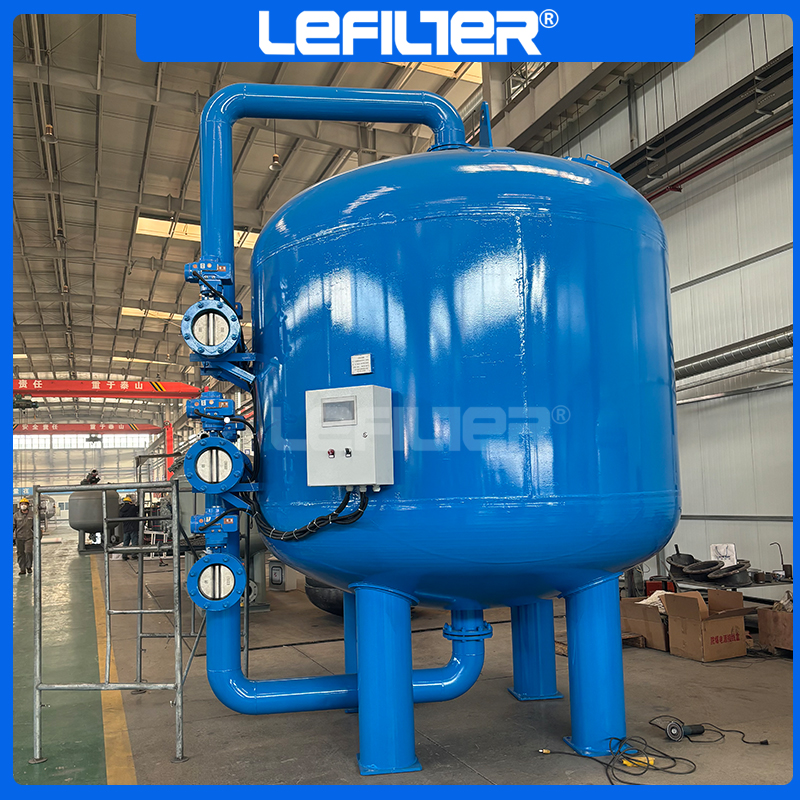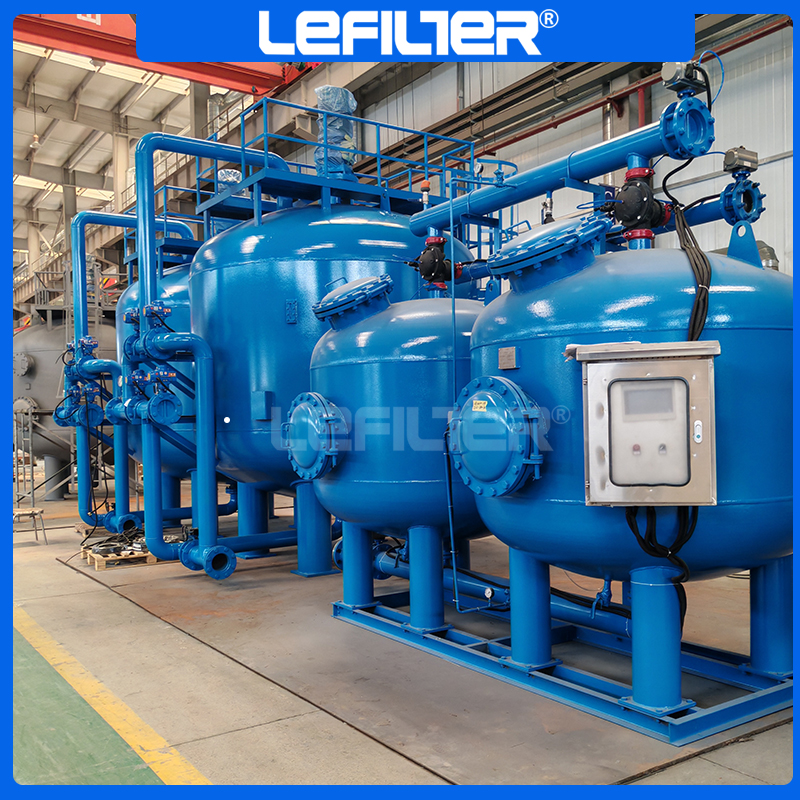Introduction to Multimedia Filters: How They Work and Applications
DATE:2024-09-24 Number of views: 1 Source:dongwenhui
Water treatment is essential in many sectors, from municipal water supplies to industrial processes. Among the various technologies employed, multimedia filtration is widely recognized for its efficiency in removing particulates, reducing turbidity, and enhancing the overall water quality. Multimedia filters are a type of depth filter, relying on multiple layers of filter media to capture and retain contaminants as water flows through. We will provide an overview of multimedia filters, their working principles, materials used, and their role in different industries.

What is a Multimedia Filter?
A multimedia filter is a type of filtration system that utilizes various layers of filter media to remove particulates and other impurities from water. The design is intended to maximize the surface area for filtration while enhancing flow rates and improving the clarity of the treated water. Unlike single-medium filters, multimedia filters contain multiple layers, each with distinct particle sizes and properties, arranged in a specific order to enhance the filtration process.
In water treatment, these filters are typically employed in pre-treatment stages to remove suspended solids and reduce turbidity before more advanced treatments such as reverse osmosis (RO) or ultraviolet (UV) disinfection. By lowering the load of contaminants, multimedia filters help extend the life of downstream equipment and reduce overall maintenance costs.
What Materials Are Used in Multimedia Filters?
The effectiveness of a multimedia filter lies in its carefully chosen filter media. The layers are typically arranged from coarse to fine to promote efficient particle removal at various stages. Common materials used include:
Anthracite: A form of coal with high carbon content, anthracite is often used in the top layer due to its hardness and ability to remove larger particulates. It also has a low density, allowing it to stay on top of denser materials during backwashing.
Sand: One of the most traditional filtration media, sand forms the middle layer. Its grain size is smaller than anthracite, enabling it to capture finer particulates. Sand is valued for its availability and cost-effectiveness.
Garnet:Garnet is a dense and hard mineral, usually placed at the bottom of the filter bed. It provides the final stage of filtration, capturing the smallest particles that pass through the sand and anthracite layers.
Gravel:Often used to support the other layers and promote even water distribution, gravel also ensures proper drainage during backwashing.
These materials work together to provide graded filtration, capturing contaminants of varying sizes as water moves through the different layers.

How Does Layering in Multimedia Filters Enhance Filtration?
The key to the efficiency of multimedia filters lies in their layered structure. Each layer has different-sized particles, allowing the filter to trap a wide range of particulate sizes. The layers are arranged from coarse to fine, with the largest particles being trapped at the top and progressively smaller particles being captured in the lower layers.
This method is superior to single-media filtration because it optimizes both the removal of larger particles and the retention of smaller ones. The larger particles are removed first, which helps reduce clogging in the finer media below, thus extending the filter's life and increasing efficiency. Additionally, the graded layering allows for higher flow rates, making multimedia filters suitable for high-volume water treatment applications.
Applications of Multimedia Filters
Multimedia filters are versatile and widely used across various industries. Some key applications include:
Municipal Water Treatment:
In municipal water systems, multimedia filters are used to treat raw water before it enters the distribution system. They play a crucial role in reducing turbidity and preventing the growth of harmful microorganisms by removing suspended particles.
Industrial Water Treatment:
Many industries, such as power plants, food and beverage production, and pharmaceutical manufacturing, use multimedia filters as part of their water treatment process. These filters ensure that the water used in production is free from particulates that could affect the quality of the end product.
Wastewater Treatment:
Multimedia filters are also effective in wastewater treatment, particularly for removing solids from effluent streams before discharge or reuse. They help reduce the load on other treatment processes, making wastewater treatment more efficient.
Desalination Plants:
In desalination plants, multimedia filters are often used as pre-treatment to remove suspended solids before the water undergoes the desalination process, ensuring that downstream equipment such as reverse osmosis membranes remains free from fouling.
Benefits of Multimedia Filters
The advantages of multimedia filters extend beyond their ability to remove particulates from water. Some notable benefits include:
High Efficiency: The multi-layered design allows for the effective removal of particles as small as 10-20 microns. This results in clearer water with reduced turbidity, improving water quality for a variety of applications.
Cost-Effective: By using different media types, multimedia filters reduce the need for frequent replacement or maintenance of more expensive downstream equipment like membranes and UV systems. This makes them a cost-effective option for large-scale water treatment.
Scalable: Multimedia filters can be used in both small-scale and large-scale applications, making them a versatile solution for different water treatment needs.
Backwashing and Maintenance of Multimedia Filters
To maintain the efficiency of multimedia filters, regular backwashing is essential. Backwashing involves reversing the flow of water through the filter to remove accumulated particles and re-distribute the filter media. This process is typically automated in modern systems and can be triggered based on pressure drop measurements or time intervals.
The frequency of backwashing depends on the quality of the incoming water and the size of the filter. In industrial applications, backwashing may be required daily, while in municipal systems, it might be done less frequently, such as once a week.

FAQ
What is a multimedia filter?
A multimedia filter is a type of filtration system that uses multiple layers of different filter media to remove particulates and impurities from water.
What materials are used in multimedia filters?
Common materials include anthracite, sand, garnet, and gravel, each serving a specific role in capturing particles of various sizes.
How does layering in multimedia filters enhance filtration?
The graded layering from coarse to fine media allows for the efficient removal of particles at different stages, improving overall filtration efficiency.
What industries use multimedia filters the most?
Multimedia filters are widely used in municipal water treatment, industrial water processing, wastewater treatment, and desalination.
How often should multimedia filters be backwashed?
Backwashing frequency depends on the system and water quality, ranging from daily to weekly in most cases.
What is the typical lifespan of a multimedia filter?
With proper maintenance, a multimedia filter can last 5-10 years, depending on water quality and usage conditions.
Can multimedia filters be used for wastewater treatment?
Yes, multimedia filters are effective in removing particulates from wastewater before further treatment or discharge.
How does multimedia filtration compare to other filtration technologies?
Multimedia filtration offers a cost-effective, efficient solution for particulate removal compared to single-media filters, with the added benefit of higher flow rates and reduced fouling.
In conclusion, multimedia filters play a critical role in modern water treatment systems, offering versatility and high efficiency across a wide range of applications. From municipal water supplies to industrial processes, these filters provide a cost-effective solution for improving water quality and protecting downstream equipment.
Industry Solutions
Pure Water /Ultra Pure Water System


